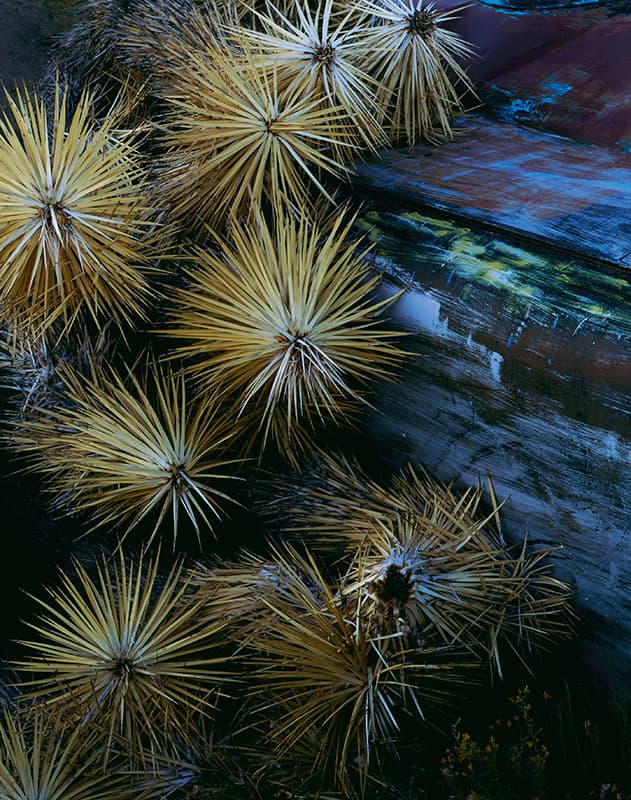Photo Insight with David Ward – Joshua Tree

David Ward is one of the UK’s finest landscape photographers. With more than 20 years’ experience in large-format photography, he has photographed extensively throughout the UK and in countries such as Canada, Iceland, Norway and France. He has also led workshops for Light & Land. David has written two books on his photographic philosophy called Landscape Within and Landscape Beyond. Each month, he will discuss the story behind one of his fantastic landscape photographs
While on a trip to a near-abandoned town in the USA, David Ward happened upon the right subject but the wrong light. He talks us through the ‘Joshua Tree’ picture that was worth waiting for
This image was taken at Goldfield in Nevada, which is a more or less abandoned town in the USA. It used to have a population of about 50,000, but now there are just a couple of hundred people. They closed the railway that was the lifeblood of the town back in around 1988 and people just walked out. There was no money coming through the town, as the trucks had gone elsewhere, the casinos had closed and things slowly fell apart. House prices plummeted and people couldn’t sell them, so they just locked the doors and walked away. You can’t imagine that happening in the UK!
The car that features in this image looked as though it had crashed into a ditch. It was lying in the bottom of a dry stream bed and was on its side, with the Joshua tree that inspired this image’s title having fallen onto it. I wonder if someone had, rather drunkenly, crashed into the tree one night and then just walked away.
Three nights prior to capturing this image, I’d already shot pretty much the same composition. The light had been very warm, with an almost psychedelic sunset, and there was a lot of what Joe Cornish calls ‘borrowed light’ – warm reflected light – all over the car. I’d shot an image, but I wasn’t too happy with it because I thought that it would probably kill all the subtle colours in the eroded paintwork and in the leaves of the Joshua tree. So when I went back a couple of nights later, I thought I’d shoot it again but in more overcast conditions.

When I got the pictures back I processed them and knew that I had made the right decision. The cold colour scheme works really well. The blues and the reds are all mixed up in the paint that has been eroded away by the desert wind. The car had been sandblasted over however many years it had been lying there. The tree is very abstract. There are just the spiky starbursts of the leaf patterns against the metalwork, so the whole thing becomes a very graphic abstract image.
I suppose both subjects are forms of death: the tree is dead and the car is dead. That, to me, says a lot about deserts. I was quite moved by the town, as it’s a remarkable place. The highway that goes through it used to be a major route in the 1950s, but all the tourist traffic now goes on the parallel road that takes a more scenic route through Death Valley. The whole town has been kind of sidelined and abandoned. I suppose the image is sort of about abandonment.
I could have stood back and shown the dramatic car smash in this scene, but I don’t think that approach leads the viewer to try to bring their own interpretation to the picture, which is what I like to do. I can’t guarantee that they’re going to see the picture in the same way as I do, but by making it a picture puzzle there is more of a chance that they’ll at least look at it and try to figure out what’s going on. That degree of intrigue is likely to lead people to make an effort. To be fair, to some people it won’t, as they’ll just be turned off by it, say they don’t understand and walk away, but for others it’ll make the image more rewarding.
Recently, I gave a talk in Cumbria, and someone who was listening joked to me afterwards that the scenery was always best on radio plays. What he meant was that if you let the viewer bring their imagination to bear on a picture, while they might not interpret it the same way as you, they may have an equally rich but slightly different interpretation.
The photograph has a multitude of lives. If you present it in a very straightforward way you show it to the viewer as an answer, not a question. The viewer looks at it, sees what it is and then moves on. It’s the difference between a poem expressing the emotion of death and a paragraph describing it. Imperfectly, I try to make visual poetry rather than visual prose. That’s one of my ambitions. How often I succeed, I don’t know!
To see more of David’s images or to book a place on one of his workshops, visit www.into-the-light.com
David Ward was talking to Jon Stapley








